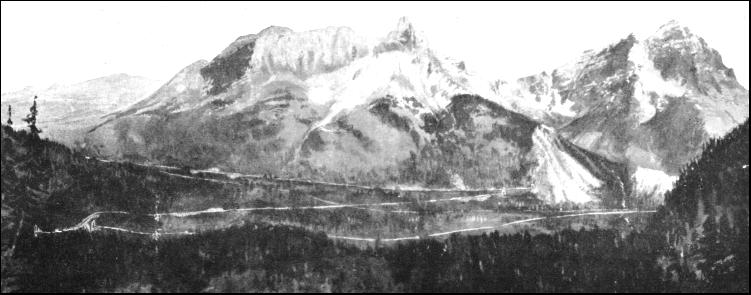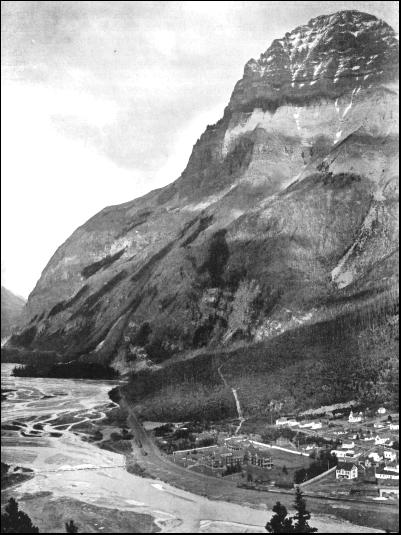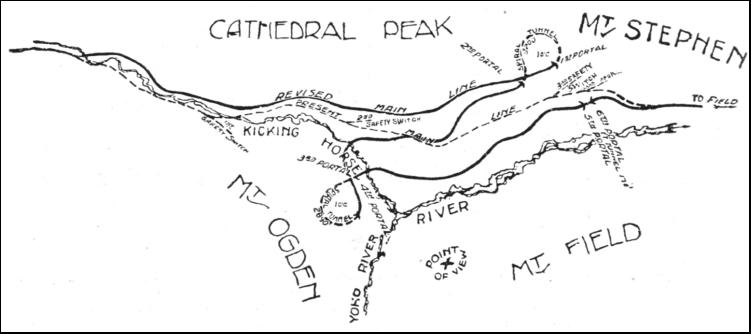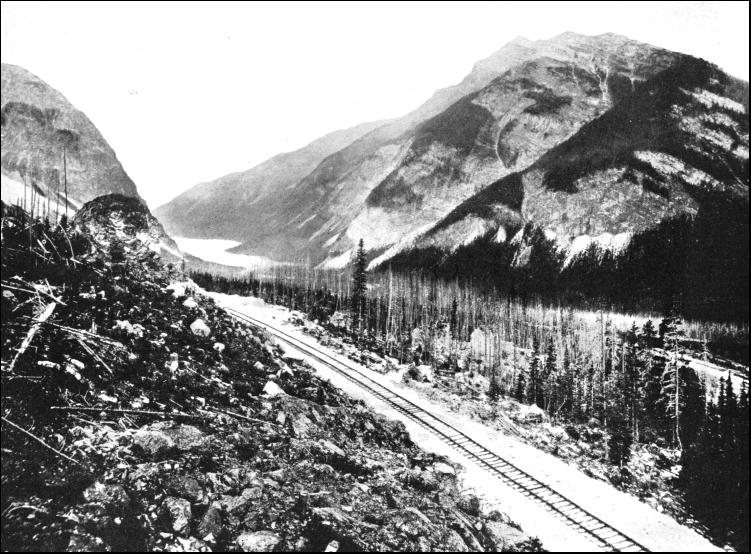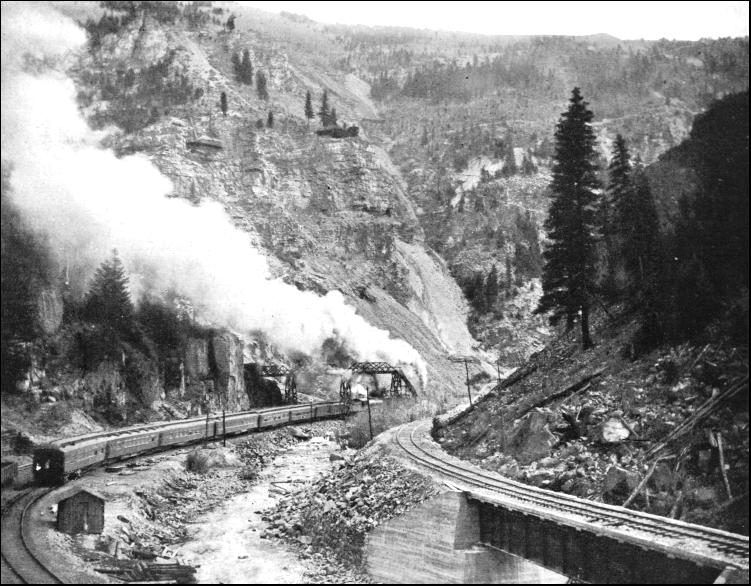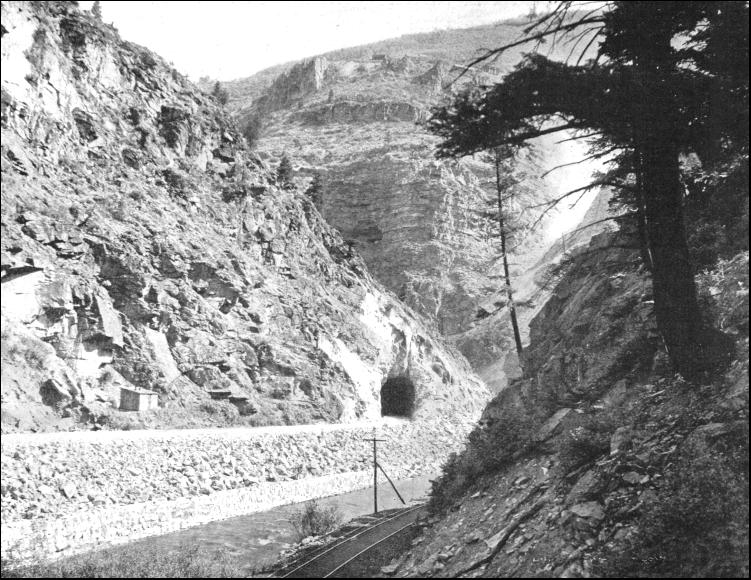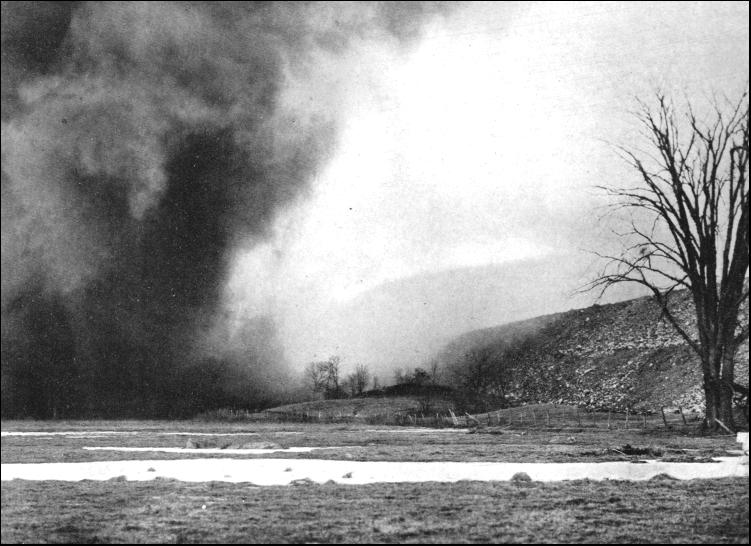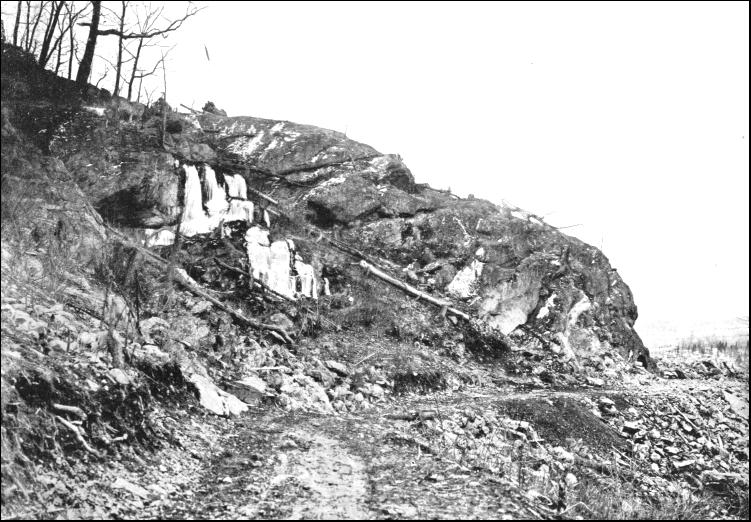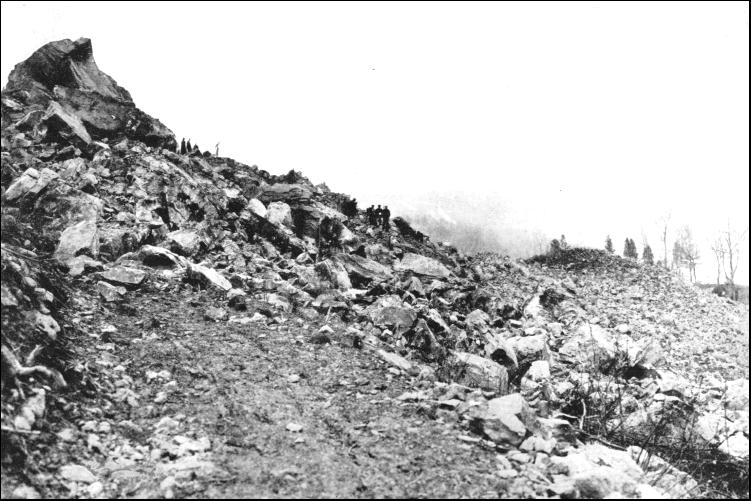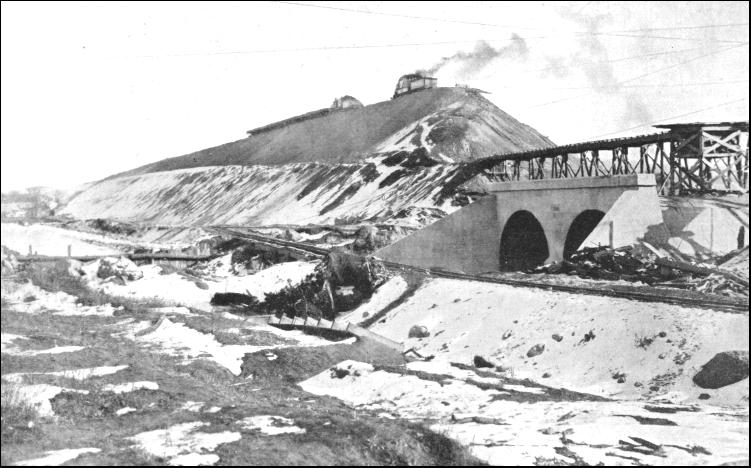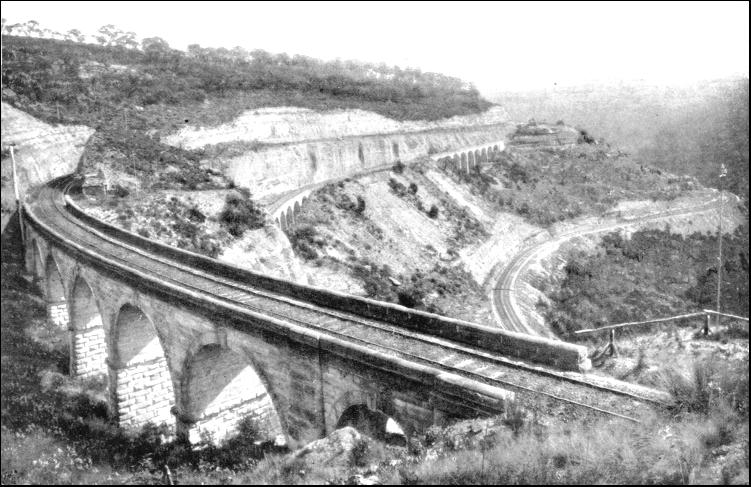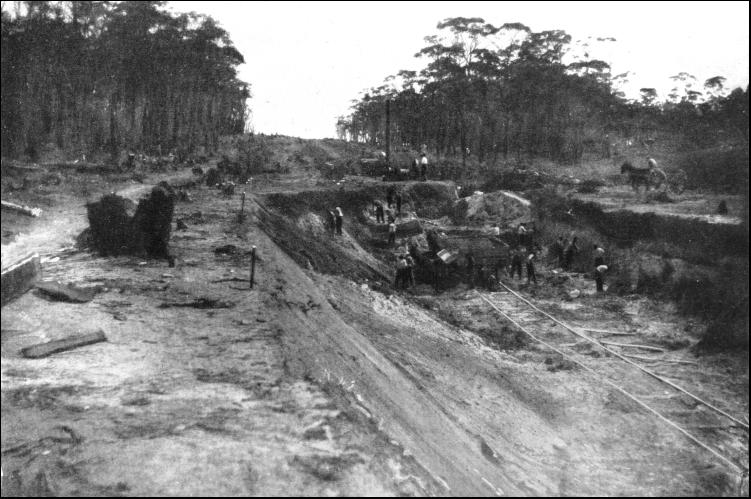By F. A. Talbot |
|
IN the early days of railway building engineers were given very few opportunities to display their genius and skill. Money was scarce, and the craving for this system of transportation among the public, after it had survived the first wave of prejudice, was so insistent that the lines had to be laid with the utmost possible dispatch. Accordingly, the lines were laid without any regard to gradients and curves. If a hill stood in his path the engineer did not pause to drive his way through the obstruction ; he either ran round or over it. A line built upon this system certainly was an amazing piece of work, as it followed the inequalities of the ground, and twisted in loops and curves like a drawn-out spiral spring. In the course of a few years, however, the original lines broke down completely under the increased traffic, or were in danger of extinction by better-built and later rivals. In frantic haste the engineer was seized and told to straighten out the original track, so as to permit faster running and heavier loads with less expense.
So far as Great Britain is concerned, there has been little evidence of elaborate remodelling. The railway was a product of this country, and the men who evolved the invention, as a result of their years of patient experimenting, were more familiar with the possibilities of this method of transportation than those who embraced it afterwards. Some of our railways, however, have short sections of steep grades and sharp curves which have not been abolished yet. The most striking instance, perhaps, is afforded in Cornwall, where, for year after year, the Great Western Railway found the tortuous rising and falling line built by Brunel a heavy drag upon its service. The expresses were able to thunder over the 225-3/4 miles between London and Plymouth at a speed of 54.9 miles an hour ; but on the continuation of the journey through Cornwall to Penzance the speed dropped to 30 miles per hour. The development of the Cornish health and pleasure resorts demanded higher speed between Plymouth and Penzance, as well as heavier trains. This, however, was impossible under existing conditions, so the company, without more ado, set to work to pull out Brunel's line : flattening his grades, easing his curves, rebuilding his bridges, and laying a double track. In this manner it has been possible to bring the Cornish tail up to the standard of the rest of the system. But the expense has been enormous. But this work of remodelling is revealed in its most compelling form in other countries, especially in the United States and Canada. In both instances the first lines were laid hurriedly and cheaply in order to open up the country, or to link together towns which were isolated hundreds of miles apart. The sleepers were thrown on the ground and the rails "tacked" to them. The engineer, having plenty of elbow room, wandered hither and thither with his permanent way, in order to complete construction quickly.
The majority of these early roads are in service to-day, but so improved as to defy recognition by those who carried them out in the first place. Summit levels have been reduced by driving tunnels at lower elevations, so as to avoid tedious, laborious climbs and waste of engine power ; chords have been cut across loops to reduce distances ; bridges have been thrown across rifts and ravines which originally were avoided by detours ; and banks have been lowered. Mr. E. H. Harriman, when he was called before the Interstate Commerce Commission, expressed the opinion that every American railway would require to be rebuilt, and it is estimated that over £200,000,000 has been expended in the task of reconstruction. The expense of overhauling many of the lines has exceeded the initial cost of building them. The American railway controllers have not been by any means parsimonious in their enterprise. Miles of lines have been abandoned in favour of easier new routes, and the vigilant traveller, as he wanders about the continent, can see long lengths of these derelicts rusting in the sand, overgrown with weeds, or undergoing burial by rock and land slides. Nowadays curves and grades are voracious. The waste they represent is tremendous. There is a single curve on a busy continental road just outside Chicago which represents a dead loss of £40 a day to its company. Another line lifted dips and lowered rises in the permanent way, as well as straightened out curves, for a distance of sixty miles, so as to secure high speeds and to hold its own against competition. The Lake Shore and Michigan Railway was handicapped sorely by the meandering of 1-1/2 miles of line near La Porte, Indiana. The engineers overcame the drawback by pulling the faulty section to pieces and laying a straighter and faster length of track ; but it cost them £50,000 to achieve their end.
In connection with this reconstruction work some startling and prodigious achievements have been and are being consummated. When the Canadian Pacific Railway was built from coast to coast the practice which had governed the building of the first American transcontinental road was followed ; the line was flimsily built, the governing considerations being completion in the minimum of time with the lowest possible cost. But the inevitable happened. The line was overtaxed, and overhauling had to be taken in hand without delay. The most serious obstacle was in the Rocky Mountains. Here the constructional engineers, in order to avoid expense, had introduced a bank 4.1 miles in length with a grade of 4.5 per cent.—237.6 feet per mile. It was so steep that it became known throughout the system as the "Big Hill." It arose from the suddenness with which the ground falls away through the Kicking Horse Valley between Hector and Field. The Big Hill came to be dreaded by all the drivers who ran through the Rockies. When they reached the top of the bank they shut off steam and tried their brakes. They descended by sheer gravity, applying the brakes now and again to keep the train in check. Switches were introduced here and there, and the switchman listened attentively for the approaching train. If the whistle tooted a certain signal the main line was left open, but if the whistle blared out another cry the switchman knew that the train had got out of control ; he promptly opened the switch, and turned the runaway into a bank. One driver who had handled the heavy freight trains which go down to Vancouver gave me his opinion that "running down the Big Hill licked a lottery to fits. You were certain to hit the bottom of the valley all right, but whether via the railway tracks or in a bee-line through the air it was impossible to say !" As may be supposed, derailments were by no means infrequent. While the run down the Big Hill was full of excitement to the freight train, the ascent was trying to the Overland mail. The train, as a rule, weighed about 710 tons, and a bank such as this was too much for a single engine. At Field they kept a full stable of "pusher" locomotives, monsters of their day, of the 2-8-0 class, and turning the scale at 74 tons apiece. Two, four, five, and even six engines have been requisitioned to lift the mail over that hump, and the roaring and belching as the locomotives struggled up at a crawl of five or six miles per hour transformed the rock-strewn, snow-walled Kicking Horse Valley into a veritable Inferno. When the line was first built it was indifferently ballasted, but the Big Hill became the best-laid piece of track in the mountains—it became packed with the half-consumed coal and ashes ejected from the locomotives as they snorted and struggled up the incline under their loads. The "Overland" going up the Big Hill certainly was an impressive spectacle, but it was poor business. The railway company were aware of this fact ; just how much it cost them to handle the trains over this fearsome bank only they themselves know. At last the management decided to eliminate this drag upon the high efficiency of their system. "The railway must be realigned through the Kicking Horse Pass. Never mind what it costs." This was the official ultimatum to the engineers, and Mr. J. Schwitzer sallied out to fulfil the commands. He searched every nook and cranny of this wild, forbidding stretch of the mountains, and finally came home with the best scheme that engineering science could offer to deal with a difference of 952.5 feet in a handful of 4.1 miles. It was a daring proposal, and it introduced an ingenious solution of a difficult problem, which, though common in Europe, was quite new to the American continent. He decided to use the same device as Hellwag had adopted to secure extrication from a similar tight corner on the St. Gotthard railway : the spiral tunnel. The Kicking Horse Gulch did not give much elbow room for the work ; but Schwitzer outlined a plan which, although it doubled the mileage through the pass, yet reduced the gradient exactly by one-half. The scheme was daring, but was carried out. In entering the pass from the west the railway plunges into a tunnel 170 feet long under Wapta Mountain. Then it swings away from the old line, which traverses the centre of the pass, cuts across the Kicking Horse River, and burrows into the base of Mount Ogden on the opposite side of the ravine. This tunnel is 2,012 feet in length, and therein the train completes a corkscrew twist, emerging into daylight almost directly over the portal, some feet below, by which it entered the mountain. It then runs along the Kicking Horse Valley, crosses the river, doubling back upon itself, running almost parallel with the first part of the line, but in the reverse direction, to gain the opposite side of the valley once more, where it penetrates Mount Stephen to describe another elliptic curve in a tunnel 3,184 feet long. Regaining daylight, the line doubles back on itself once again, until it meets the point where the second line in the zigzag crossed the old line, which is now rejoined. It is a railway maze, the line doubling upon itself twice and crossing the river twice, in order to reduce the severity of the incline.
The total length of the new line is 8.2 miles, and in no place is the gradient heavier than 1 in 45.45 feet. In the spiral tunnels, which have a curvature of 573 feet radius, it was found possible to give an easy grade. In the completion of the work 700 men found employment. The two spiral tunnels were driven from each end simultaneously, compressed air rock-drills being used to break down the rock, which, being of siliceous limestone, somewhat facilitated rapid progress. Here and there searching difficulties were encountered. The rock was found to be fissured, so that water gained an entrance into the workings ; but the pumps proved able to cope with the inflow. In other instances treacherous layers of shale were struck, and heavy timbering had to be adopted, and a concrete lining afterwards completed. When the work was commenced hand labour was used for removing the spoil dislodged by the blasts, but this proved so inadequate that powerful steam shovels were brought up, and they kept pace with the drills and dynamite. These shovels were driven by compressed air, so as not to foul the workings. Work was maintained at high pressure the whole time, the tunnels being brilliantly lighted, so that excavation might continue night and day uninterruptedly, while in the open workings oil flares served sufficiently to illumine the scene through the hours of darkness to enable progress to be maintained. At times there was a shortage of men, especially among the unskilled labourers, who, after staying a short while, and having amassed a tempting nest-egg, hied on their way to the Pacific coast, where they could command higher pay for the sweat of their brow. Despite these hindrances, however, the task was completed in about nineteen months, by which time over £250,000 had been expended, of which sum £50,000 vanished in smoke alone, as 1,500,000 pounds of dynamite, sufficient to fill seventy-five box cars, were consumed. But the reconstruction has repaid the Canadian Pacific Railway Company. Whereas formerly a battery of powerful locomotives was required to handle a train weighing 710 tons, now a train weighing 980 tons can be handled easily by a double-header at a speed of 20 miles an hour. Not only is the cost of working over this section reduced by over 60 per cent., but there is an improved time schedule, while a greater degree of safety is secured to the travelling public. When the engineer is called upon to thread a forbidding rugged mountain range, he generally takes advantage of the natural paths to carry him through the obstacle. A river is an ideal channel, although it may possess the drawbacks of wandering apparently aimlessly among the precipitous crags, making sharp twists and bends. The latter, however, can generally be circumvented by driving short cuts with tunnels across the loops. As a rule, however, the waterway is constricted, and will occupy the whole floor of the gorge, while its level fluctuates wildly. In the spring it is a babbling brook rolling peacefully along ; but in the late summer, when the torrid sun melts the snow on the peaks, causing rivulets and creeks to dance down the cliff sides into the main channel, then the waterway rises suddenly to a high level, and tears along fiendishly, sweeping all before it. Such a situation faced the engineer when he was called upon to carry the railway through Eagle Canyon, Colorado, for the Denver and Rio Grande system. He searched the ravine, and found a convenient ledge, which he seized here and there, smoothed it off, and laid down his metals. It is a V-shaped rift, with the mountains hurrying skywards on either hand from the waterway. But the ledge afforded a foundation. Where it was interrupted by knots of rock the engineer either blew them. away to the width he desired or tunnelled them—whichever was easier, cheaper, and quicker. He strengthened his rampart where it was weak with a massive stone wall, and entertained no apprehensions that his work would be washed away when the turbulent Eagle River rose in flood. But in course of time the single track used for both up and down traffic became inadequate. The Goulds got control of the line, and, what was more, at the end of thirty odd years achieved the height of their ambitions : they had a connection running to the Pacific—the Western Pacific Railway. A new source of traffic was tapped, to carry which rendered a second pair of metals through Eagle Canyon imperative. The engineer was commanded to double track the line for six miles through the gulch. It seemed a simple task to fulfil, but he had different notions. The existing ledge was just wide enough to take the one pair of rails and no more. The shelf could not be widened very cheaply, as it meant trimming back the toes of the cliffs somewhat heavily. There was another similar though not so well defined ledge on the opposite side of the river. He decided to press that to his aid. The first thing was to control the waterway, to keep it within bounds, so that it could not thunder, foam, and tumble where it pleased. He threw up a massive masonry wall. In so doing he drove the water back somewhat, but to guard against all risk, the existing ridge was fortified with new masonry here and there. The result is that to-day the Eagle River ripples or rushes, according to its mood, along a big ditch, fenced in on either side by a heavy, well-built masonry wall, which defies the waterway's most violent outbursts of frenzy. By being compelled to take to the opposite side of the river for his second line, the engineer was brought face to face with another obstacle. The cliffs are steep, but here and there they are scarred by wide gullies filled with loose rubble and detritus. These are the tracks of avalanches, rock-slides, and landslips. They are well defined, and the movements follow these passages every year, as certainly as night follows day. These destructive forces had to be avoided ; accordingly the engineer swung his line across the waterway to the existing shelf, widening it out to suit his purpose. At places the ledge was interrupted by a spur which dropped sheer into the water. If it was not too formidable, the engineer blew the mass out of the way ; in other instances he tunnelled it. It was a stupendous task, and by the time the two sets of rails had been laid a distance of five miles £100,000 had been spent. Yet it was considered to be well invested, because it enabled double the traffic, at least, to be handled through the rift. As the engineer, in building the second track, kept down the grade, and made the curves easy, it was selected for east-bound trains, as there was less resistance to the locomotives, which had to overcome a rise of 116 feet as compared with 174.24 feet per mile on the old line. Originally it was intended to rebuild the pioneer track with flatter inclines ; but as its steep grade is in favour of westbound traffic, it has been retained. This selfsame system has groaned for years under the handicap of a big hump which was introduced in the early days between Tucker and Soldier Summit, in order to carry the railway across the Wasatch Mountains, Utah, into Salt Lake City. It was a serious obstacle to economic and rapid operation, since the drag is seven miles in length, and the gradient is 4 per cent.—211 feet per mile. In other words, the train had to rise 12 inches for every 25 feet it advanced. Stalls of pusher and header locomotives were kept in readiness at the bottom of the hump to give a passing train a lift. When the "Fast Denver Limited" was being put over the bank the spectacle was thrilling. This magnificent crack train is made up of eleven heavy Pullman cars, and in order to maintain the speed and to keep time up the hill, five engines had to be called into service, four monsters tugging for all they were worth, with a fifth pushing just as hard at the rear. When the rails were greasy under snow or drizzling rain, even this collection of engine power experienced a stiff struggle to keep up the regular speed. The hump was tolerated until the close of 1912, when President Bush and Vice-President Brown, of the railway system, laid their heads together and decided to cut it out at all costs. Such drastic action was imperative. The Western Pacific was open, giving Denver a new outlet at San Francisco.
The business over this new artery is increasing rapidly, and at the same time the mineral traffic is rising by leaps and bounds, owing to the enormous shipments of coal and coke from the Utah mines to the Salt Lake, Nevada, and Montana smelting and reduction plants, which have become busier owing to the provision of improved transport facilities offered by the Western Pacific Railway. The Denver and Rio Grande Railway plays a prominent part in this development, so the overhaul of the Soldier Summit Hump on its main through line could not be delayed. In response to official instructions, the engineers located a new route, which, although increasing the distance between the two points from seven to fifteen miles, at the same time presented half the grade, and a reduction in the curvature. The administration decided to accept this solution, and a contract was made immediately for the cutting out of the hump. By means of the new track the rise is brought down to only 1 in 50—the maximum on the Denver and Rio Grande main line system. The cost of these fifteen miles of new line was unavoidably heavy, the contract with the Utah Construction Company, one of the great railway building forces of the Middle West, being for £300,000, or £20,000 per mile. The railway, however, called for a double, instead of a single line, the old road being abandoned completely. The revision work was of an exceedingly arduous character, the revised route running through heavily undulating country. Although no bridges were necessary, several concrete arches were required, together with one tunnel, 255 feet in length. The track is heavily ballasted, and is laid with 90 lb. steel rails.
One of the most striking instances of the endeavour to straighten out a railway built in a hurry was on the Delaware, Lackawanna and Western Railroad. As in the case of other systems of today, this railway had a modest beginning, but as time progressed it threw out additional tentacles ; absorbed short lines that stood in the way ; and these threads were welded into a homogeneous whole. An intricate network of lines stretching from the Great Lakes to the Atlantic seaboard, and penetrating the rich coal areas of the Eastern States has been woven in this manner. The district threaded is very mountainous, and the original engineers ran their lines through the natural cracks in the mountains, paying no regard to the big detours, and troubling little about grades and curves. The result was that when later railways penetrated this rich territory with straighter, flatter, and shorter routes the original system found its traffic threatened. This menace assumed serious proportions. Between Hopatcong and Delaware Gap the company possessed as bad a stretch of 39-1/2 miles, as could have been built. It abounded in curves which, in the aggregate, described fifteen and a half circles, representing nearly 13 miles, while grades ran up as high as 60 feet per mile. These conditions limited the load per locomotive to thirty cars, as compared with seventy-five similar wagons which were hauled by one engine on competitive roads. Such a disadvantage could not be tolerated. Accordingly the engineer was called in and told by President Truesdale to find a shorter cut between the two points at any cost. Accordingly a new route was discovered showing a saving of 11 miles, the wiping out of four and a third circles of curvature, and a grade reduction to 29 feet per mile at an estimated cost of approximately £2,000,000. Despite the alarming proportions of the cost, the engineer estimated that one hour could be clipped off the running time of the goods trains, and twenty minutes off the schedule for the expresses ; and that the saving in working and maintenance charges would be sufficient to defray interest on £2,100,000. Thus the engineer was on the right side, and accordingly was told to "go ahead." It was a daring scheme. Here were 39-1/2 miles to be wiped out of existence and a new line, 28-1/2 miles, to be built at something like £66,000 per mile. Mr. G. J. Ray, the engineer-in-chief, ventured to me his opinion that this "work is the heaviest per mile of any large railway ever undertaken in the United States." The earth and rock excavation averaged about 500,000 cubic yards per mile. This will afford some idea of what was entailed in carrying out the Lackawanna Cut-off, as it was called. There was a heavy premium on the services of dynamite and steam shovels. The cuts were amazing ; the embankments startling. There was one wide valley among the tumbling ridges, which ran transversely to the location. "How was that to be filled ?" asked the farmers in the depression. "By an embankment," retorted the engineer, and before the agriculturists in the valley realised the significance of this work, overtures were being made to buy out their farms. The base width of an embankment ranging from 75 to 110 feet high would be too great to be accommodated in the ordinary right-of-way, while, had the railway purchased just the necessary strip of land, such little pieces of farms would have been left that they would not have been worth cultivation. The farmers accordingly were compensated with big cheques for their property, and went off to pastures new, while the railway engineers set to work building up the massive ridge of the Pequest Fill, with over 6,600,000 cubic yards of spoil. The plant turned to work on this cutoff represented a fortune in itself. One contractor had sufficient engines and cars to run a small railway, and he valued them at £40,000. Every possible device which would hasten construction, and save time and labour, was adopted. The ridges were not built up in the ordinary dumping way. A ropeway was stretched across the ravine, and from this was suspended a track laid on sleepers. The engine backed the loaded trucks on to this swinging track to be emptied. At other points towering timber trestles were erected. Rails were laid on top, over which the ballast cars rumbled and dumped their loads until every sign of the timber had disappeared beneath the big earthen bank. The cuttings were as stupendous as the embankments. There is one as deep as the Pequest Fill is high, the trains hurtling along a huge trench 100 feet deep. In one instance the builders drove their way for half a mile through granite, wherein the persuasive efforts of dynamite were required to dislodge 1,000,000 cubic yards of rock. Some of the blasts were strikingly large. In a single detonation 40,000 lb. of dynamite shivered a complete mountain nose. Smaller blasts, ranging up to 1,000 lb., were almost of hourly occurrence. In fact, the demands for this rending and splitting agent were so steady and large that a factory was set up near Hopatcong for its manufacture upon the spot, supplies being delivered as required by the wagon load. By the time the track was opened for service over 5,000,000 lb. of dynamite had been used.
It was cutting and embankment, with stretches of bridging, for every yard of the way. Over 13,000,000 cubic yards of earth and rock were dislodged from the cuttings to build up the embankments, which absorbed some 15,000,000 cubic yards of spoil, the balance of the material being hauled from ballast pits which were opened at convenient points. Then sixty-five bridges were built over rivers and roads, ranging from a single arch of 33 feet span to a structure 1,450 feet from end to end over the Delaware River. This latter is the largest structure on the cut-off, handsomely wrought in concrete, comprising five spans each measuring 150 feet, two of 120 feet, and two small arches over the railway tracks, each of 33 feet, with the metals laid 65 feet above the ordinary level of the river. Paulins Kill Bridge is the second largest. It is 1,100 feet long, built up of five 120-feet spans and two 100-feet spans, with the rails 115 feet above the level. The bridges consumed 225,000 cubic yards of concrete. The expenditure of £2,000,000 for a mere 28-1/2 miles conveys some idea of the extremities to which the older American railways are forced to go in order to retain their traffic. In this instance the Lackawanna has more than recouped its losses, and is, in fact, placed at an advantage as compared with its rivals.
The Chicago, Milwaukee, and St. Paul Railway embarked upon a striking piece of grade revision across the Des Moines River Valley near Madrid. Seven miles of existing line were scrapped in favour of a new line five miles in length, whereby 791 degrees of curvature were eliminated and the gradient lowered by 96 feet. The new track has been driven as straight as engineering ingenuity can contrive. Where the line crosses a deep chasm an artificial mountain was created so as to preserve the grade for a double track, while the river itself is spanned by a dizzy bridge of steel, the feature of which is that the permanent way is ballasted, instead of the rails being laid on longitudinal timbers. In this realignment the stations were moved two and three miles across country from the old to the new road. When the railway invaded Australia the engineers were confronted by some abnormal differences in level within short distances, owing to the abrupt configuration of the mountain flanks. This was especially the case in New South Wales and Western Australia, where the Blue Mountains and the Darling Range respectively had to be overcome. But the natural difficulties were not the most serious : official ignorance was a far heavier millstone around the necks of the railway plotters, and some very quaint ideas were entertained by the powers that were concerning the operation and possibilities of the railway locomotive. It took Mr. John Whitton a long time and considerable detailed correspondence, as well as explanations and diagrams, to convince his superiors that a railway engine really was superior to the horse in haulage work !
The trouble arose over the question of carrying the railway onwards from Penrith over the Blue Mountains to Bathurst. A sheer drop of 470 feet had to be negotiated. The engineer-in-chief wanted a tunnel, or series of tunnels, to preserve the grade ; but burrowing was expensive, and it was ruled out of court. The engineer stuck to his ideas, however, and so pestered officialdom that he got his way up to a point, but was given a limit of £20,000 per mile.
Such a stipulation prevented tunnelling as originally planned, so the engineer devised an ingenious way out of the difficulty. He brought the railway to the base of the drop, and then started out to climb up one leg of the V to the highlands above. The line could not be taken up in a single run, as the gradient would have been too heavy—those were days before the rack came into vogue—so he sawed his way up the slope. The line crawled upwards along a winding incline at 1 in 42 from one end of the ravine to the other. Here there was a dead end, but another gallery was hewn out of the cliff on a similar incline, only in the reverse direction to another dead end, from which a third ascending grade carried the line to the top. It was exasperatingly slow and perilous work, cutting the three ascending shelves in the mountain-side, following its windings, and erecting massive masonry viaducts over the deep rifts. In ascending the mountain-side the engine hauled the train along the bottom gallery to the dead end ; then it pushed it up the succeeding step to the second dead end, where the engine, being once more to the front, hauled its load to the top, and thence on to Bathurst. The "Zigzag," as this striking example of engineering skill was called, became one of the sights of the country, but in course of time it played havoc with economical operation. Train weights became limited as well as speeds, and this threatened a congestion of traffic. Accordingly, the issue of eliminating the Zigzag arose. It was certain to be a costly proceeding. This fact was realised fully, but overhaul in railway work is always costly.
A new scheme was prepared, and, like the original project, it was debated, revised, restored, pigeon-holed, and revived in turn. At last, in response to pressure, it was attacked boldly, and a new location was made so as to avoid the Zigzag altogether. It was a wide, circuitous deviation, entailing deep cuttings and heavy tunnelling through projecting spurs and humps protruding from the main range. The tunnels, ten in number, for the most part are short ; but some of the cuttings are of immense depth, one having walls of earth sloping upwards for 132 feet. Grades were eased, and the curves opened, the banks rising 1 in 90 instead of 1 in 42, while the curves are of 924 feet instead of 528 feet radius. By the time the task was consummated about £350,000 had been expended to bring this short length of seven miles into conformity with modern railway ideas. This re-modelling process is being pushed forward more feverishly than ever in all parts of the world. Every country is having to pay a heavy penalty for the mistakes of the pioneers. Every minute which can be saved is vital to the operation of a railway in these days of bitter competition. "Spending millions to save minutes" may have become a trite expression, but it is the governing watchword of every railway between the two Poles.
Many thanks for your help
|
   Share this page on Facebook - Share  [email protected] |

